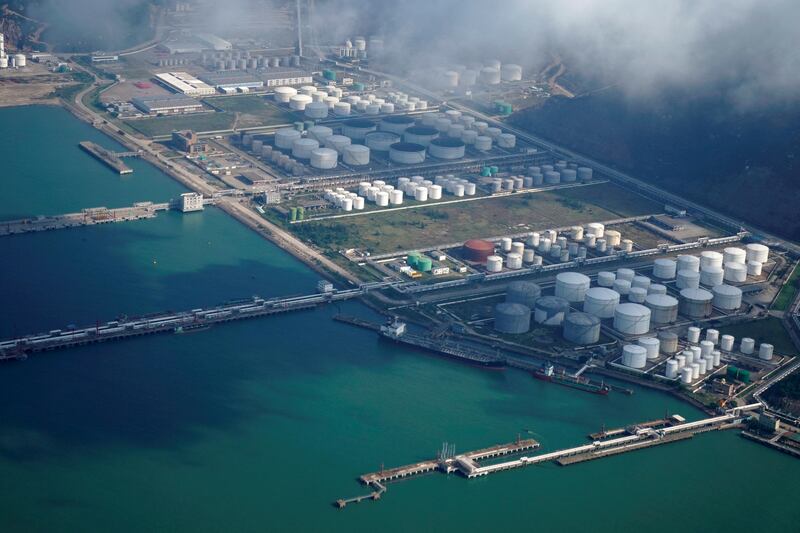Oil prices settled 2 per cent higher at the close of trading on Friday, but eased for a second consecutive week after member nations of the International Energy Agency and the US announced plans on Thursday to release more crude from their strategic stockpiles.
Brent, the global benchmark for two thirds of the world's oil, settled 1.5 per cent lower for the week at $102.78 a barrel at the close of trading on Friday. West Texas Intermediate, the gauge that tracks US crude, closed 1 per cent weaker at $98.26 a barrel.
The price of Brent dropped to $99.92 per barrel in early trading on Friday, the first time it moved lower into double-digits since mid-March, but pared losses.
The benchmarks have experienced their most volatile period since June 2020 in the past several weeks because of Russia's military offensive in Ukraine.
The conflict has caused crude prices to soar, with Brent rising to a notch under $140 per barrel in March. It is still up 32 per cent since the beginning of this year.
Russia is the world’s second largest energy exporter behind Saudi Arabia, according to the IEA.
Russia supplies about 19 per cent of the world’s natural gas and 11 per cent of oil. Europe, in particular, is highly dependent on Russian supply of hydrocarbons, the Paris-based Organisation for Economic Co-operation and Development said.
About 27 per cent of EU crude oil imports, 41 per cent of its natural gas imports and 47 per cent of solid fuel imports come from Russia, the OECD said.
Another 20 per cent of Russia’s oil exports go to China, the IEA figures show.
The market is closely watching China, as the world’s largest importer of oil grapples with a new wave of Covid-19 infections that has stoked concerns about waning consumption.
“Crude prices have stabilised as the announcement of the co-ordinated stockpile release and China’s demand destruction driven sell-off has run its course. Rising rig counts, however, are being met with labour shortages and that will delay some crude production increases in the US,” said Ed Moya, senior market analyst at Oanda, in a note.
“The oil market is still tight, but if China’s lockdowns have no end in sight, crude prices could still weaken by another 3 [per cent] to 5 per cent.”
The IEA's stockpile release, announced on Thursday, includes 120 million barrels of oil, half from the US and half from other members. This is in addition to the US releasing 120 million barrels from its Strategic Petroleum Reserve, which brings the total to 240 million barrels worldwide.
The commitment is the largest from the 31 member nations in the agency’s 47-year history.
“The unprecedented decision to launch two emergency oil stock releases just a month apart, and on a scale larger than anything before in the IEA’s history, reflects the determination of member countries to protect the global economy from the social and economic impacts of an oil shock following Russia’s aggression against Ukraine,” said Fatih Birol, executive director of the IEA.
“This latest collective action once again demonstrates the unity of IEA member countries in their solidarity with Ukraine and their determination to provide stability to the oil market during this challenging time. Events in Ukraine are becoming more distressing by the day, and action by the IEA at this time is needed to relieve some of the strains in energy markets.”
Japan will release an additional 15 million barrels of oil reserves as part of the co-ordinated effort by IEA members to stabilise the market, Japan's Kyodo news agency reported on April 7.
The release by Japan, tapping both private and state reserves, will be one of the largest by the country and the second largest contribution after the 60 million barrels from the US, it said.
Barring a breakthrough in Russia-Ukraine peace negotiations, the price-induced demand destruction necessary to reduce consumption is set to become widespread by the third quarter, with a corresponding Brent crude oil price above $140 per barrel, said Ehsan Khoman, head of emerging markets research at Japan's MUFG Bank.
This is the "maximum pain level" that could jolt corporate activity, squeeze private consumption and ultimately begin to ease the market’s severe tightness, he said.
The oil price shock will exacerbate supply chain disruptions brought on by the pandemic, hurt households and disrupt the production of goods and services worldwide, OECD secretary general Mathias Cormann said last month.
Global energy spending is set to reach a record $2.1 trillion in 2022, led by oil and gas as well as rising power prices and the EU reducing its reliance on Russian imports, Oslo-based consultancy Rystad Energy said.






